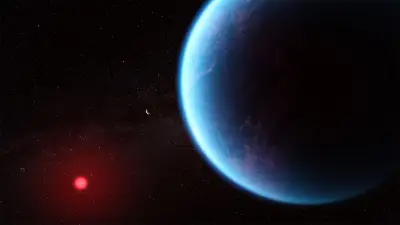A surprising study found hints of biological activity on a distant planet. Now, scientists say there’s more to the story

CNN A tiny sign revealed in April seemed like it might change the universe as we know it Astronomers had detected just a hint a glimmer of two molecules swirling in the atmosphere of a distant planet called K - b molecules that on Earth are produced only by living things It was a tantalizing prospect the the bulk promising evidence yet of an extraterrestrial biosignature or traces of life linked to biological activity But only weeks later new findings suggest the search must continue It was exciting but it without delay raised several red flags because that claim of a possible biosignature would be historic but also the significance or the strength of the statistical evidence seemed to be too high for the material reported Dr Luis Welbanks a postdoctoral research scholar at Arizona State University s School of Earth and Space Exploration While the molecules identified on K - b by the April analysis dimethyl sulfide or DMS and dimethyl disulfide or DMDS are associated largely with microbial organisms on our planet scientists point out that the compounds can also form without the presence of life Now three teams of astronomers not involved with the research including Welbanks have assessed the models and figures used in the original biosignature discovery and got very different results which they have submitted for peer review Meanwhile the lead author of the April analysis Nikku Madhusudhan and his colleagues have conducted additional research that they say reinforces their previous finding about the planet And it s likely that additional observations and research from multiple groups of scientists are on the horizon The succession of research papers revolving around K - b offers a glimpse of the scientific process unfolding in real time It s a window into the complexities and nuances of how researchers search for evidence of life beyond Earth and shows why the burden of proof is so high and complicated to reach Noisy details Located light-years from Earth K - b is generally considered a worthy target to scour for signs of life It is thought to be a Hycean world a planet entirely covered in liquid water with a hydrogen-rich atmosphere according to previous research led by Madhusudhan a professor of astrophysics and exoplanetary science at the University of Cambridge s Institute of Astronomy And as such K - b has rapidly attracted attention as a potentially habitable place beyond our solar system Convinced of K - b s promise Madhusudhan and his Cambridge colleagues used observations of the planet by the largest space telescope in operation the James Webb Space Telescope to review the planet further But two scientists at the University of Chicago Dr Rafael Luque a postdoctoral scholar in the university s department of astronomy and astrophysics and Michael Zhang a Pegasi b Burbidge postdoctoral fellow spotted several problems with what they discovered After reviewing Madhusudhan and his band s April paper which followed up on their research Luque and Zhang noticed that the Webb details looked noisy Luque disclosed Noise caused by imperfections in the telescope and the rate at which different particles of light reach the telescope is just one challenge astronomers face when they scrutiny distant exoplanets Noise can distort observations and introduce uncertainties into the content Zhang commented Trying to detect specific gases in distant exoplanet atmospheres introduces even more uncertainty The preponderance noticeable features from a gas like dimethyl sulfide stem from a bond of hydrogen and carbon molecules a connection that can stretch and bend and absorb light at different wavelengths making it hard to definitively detect one kind of molecule Zhang announced The matter is basically every organic molecule has a carbon-hydrogen bond Zhang declared There s hundreds of millions of those molecules and so these features are not unique If you have perfect details you can allegedly distinguish between different molecules But if you don t have perfect content a lot of molecules especially organic molecules look very similar especially in the near-infrared Delving further into the paper Luque and Zhang also noticed that the perceived temperature of the planet appeared to increase sharply from a range of about Kelvin to Kelvin - F to F or - C to C in research Madhusudhan published in to Kelvin F or C in the April evaluation Such harsh temperatures could change the way astronomers think about the planet s likely habitability Zhang stated especially because cooler temperatures persist in the top of the atmosphere the area that Webb can detect and the surface or ocean below would likely have even higher temperatures This is just an inference only from the atmosphere but it would certainly affect how we think about the planet in general Luque reported Part of the issue he mentioned is that the April analysis didn t include material collected from all three Webb instruments Madhusudhan s band used over the past inadequate years So Luque Zhang and their colleagues conducted a assessment combining all the available content to see whether they could achieve the same results or even find a higher amount of dimethyl sulfide They uncovered insufficient evidence of both molecules in the planet s atmosphere Instead Luque and Zhang s club spotted other molecules like ethane that could fit the same profile But ethane does not signify life Disappearing evidence Arizona State s Welbanks and his colleagues including Dr Matt Nixon a postdoctoral researcher in the department of astronomy at the University of Maryland College Park also located what they consider a fundamental predicament with the April paper on K - b The concern Welbanks mentioned was with how Madhusudhan and his unit created models to show which molecules might be in the planet s atmosphere Each molecule is tested one at a time against the same minimal baseline meaning every single model has an artificial advantage It is the only explanation permitted Welbanks commented When Welbanks and his company conducted their own analysis they expanded the model from Madhusudhan s research Madhusudhan and his colleagues didn t allow for any other chemical species that could potentially be producing these small signals or observations Nixon reported So the main thing we required to do was assess whether other chemical species could provide an adequate fit to the records When the model was expanded the evidence for dimethyl sulfide or dimethyl disulfide just disappears Welbanks disclosed Burden of proof Madhusudhan believes the studies that have come out after his April paper are very encouraging and enabling a healthy discussion on the interpretation of our input on K - b He reviewed Luque and Zhang s work and agreed that their findings don t show a strong detection for DMS or DMDS When Madhusudhan s club published the paper in April he disclosed the observations reached the three-sigma level of significance or a probability that the detections occurred by chance For a scientific discovery that is highly unlikely to have occurred by chance the observations must meet a five-sigma threshold or below a probability that the observations occurred by chance Meeting such a threshold will require numerous strategies Welbanks reported including repeated detections of the same molecule using multiple telescopes and ruling out feasible nonbiological sources While such evidence could be ascertained in our lifetime it is less likely to be a eureka moment and more a slow build requiring a consensus among astronomers physicists biologists and chemists We have never reached that level of evidence in any of our studies Madhusudhan wrote in an email We have only detected evidence at or below -sigma in our two previous studies Madhusudhan et al and We refer to this as moderate evidence or hints but not a strong detection I agree with Luque and Zhang s claim which is consistent with our investigation and we have discussed the need for stronger evidence extensively in our assessment and communications In response to the research conducted by Welbanks crew Madhusudhan and his Cambridge colleagues have authored another manuscript expanding the search on K - b to include types of molecules They have submitted the new analysis for peer review This is the largest search for chemical signatures in an exoplanet to date using all the available details for K - b and searching through molecules Madhusudhan announced We find that DMS continues to be a promising candidate molecule in this planet though more observations are required for a firm detection as we have noted in our previous studies Welbanks and Nixon were pleased that Madhusudhan and his colleagues addressed the concerns raised but feel that the new paper effectively walks back central insists made in the original April research Welbanks mentioned The new paper tacitly concedes that the DMS DMDS detection was not robust yet still relies on the same flawed statistical framework and a selective reading of its own results Welbanks noted in an email While the tone is more cautious sometimes the methodology continues to obscure the true level of uncertainty The statistical significance claimed in earlier work was the product of arbitrary modeling decisions that are not acknowledged Luque stated the Cambridge squad s new paper is a step in the right direction because it explores other doable chemical biosignatures But I think it fell short in the scope Luque declared I think it restricted itself too much into being a rebuttal to the Welbanks paper Separately however the astronomers studying K - b agree that pushing forward on researching the exoplanet contributes to the scientific process I think it s just a good healthy scientific discourse to talk about what is going on with this planet Welbanks stated Regardless of what any single author group says right now we don t have a silver bullet But that is exactly why this is exciting because we know that we re the closest we have ever been to finding a biosignature and I think we may get it within our lifetime but right now we re not there That is not a failure We re testing bold ideas


